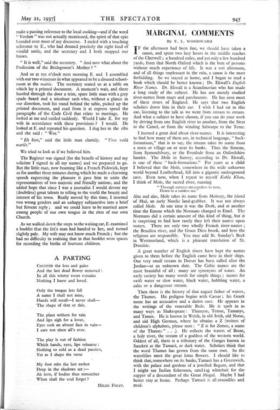MARGINAL COMMENTS
By E. L. WOODWARD
IF the afternoon had been fine, we should have taken a canoe, and spent two lazy hours in the middle reaches of the Cherwell ; a hundred miles, and yet only a few hundred yards, from that North Oxford which is the butt of persons without much experience of life. It was a wet afternoon, and of all things unpleasant in the rain, a canoe is the most forbidding. So we stayed at home, and I began to read a book which should be better known ; Dr. Ekwall's English River Names. Dr. Ekwall is a Scandinavian who has made a long study of the subject. He has not merely studied river-names from maps and parchments. He has seen most of these rivers of England. He says that two English scholars drove him in their car. I wish I had sat in this car, listening to the talk as we went from stream to stream. And what a subject to have chosen, if you can do your work by driving from one English river to another, from the Strat to the Camel, or from the winding Salwarpe to the Teme.
I learned a great deal about river-names. It is interesting to find how many of them are, in technical language, " back- formations," that is to say, the stream takes its name from a town or village on or near its banks. Thus the Simene, from Symondsbury, or the Evenlode from an Oxfordshire hamlet. The Mole in Surrey, according to Dr. Ekwall, is one of these " back-formations." For years as a child I believed that the Mole, somewhere in the wide unknown world beyond Leatherhead, fell into a gigantic underground cave. Even now, when I repeat to myself Kubla Khan, I think of Mole, the sacred river, running
"Through caverns measureless to man, Down to a sunless sea."
Alas and alas, Mole takes its name from Molesey, the island of Mul, an early Nordic land-grabber. It was not always called Mole. At one time it was the Dork, and at another time the Emene which the Nonnans changed to Emel. The Normans did a certain amount of this kind of thing, but it is surprising to find how rarely they left their names upon waters. There are only two wholly French river-names ; the Beaulieu river, and the Grace Dieu brook, and here the religious are responsible. You may add St. Sunday's Beck in Westmorland, which is a pleasant translation of St. Dominic.
A great number of English rivers have kept the names given to them before the English came here in their ships. One very small stream in Dorset has been called after the Jordan—at an unknown date. The Celtic names are the most beautiful of all ; many are synonyms of water. An early society has many words for simple things ; names for swift water or slow water, black water, babbling water, a calm or a dangerous stream.
Then there is the history of that august father of waters, the Thames His pedigree begins with Caesar ; his Greek name has an accusative and a dative case. He appears in the writings of the venerable Bede. He is spelt in as many ways as Shakespeare : Thamyse, Temse, Tammys, and Tames. He is known in Welsh, in old Irish, old Norse, and old High German, where he obtains a Z (writers of children's alphabets, please note : " Z is for Zemse, a name of the Thames " . . .). He collects the waters of Brent, a holy river, the stream of a goddess of the western world. Oddest of all, there is a tributary of the Ganges known in Sanskrit as the Tamasa, or dark water. Scholars think that the word Thames has grown from the same root. So the waterlilies meet the great lotus flowers. I should like to think that, somewhere on its banks, Tama has a Greenwich, with the palace and gardens of a jewelled Begum, and that I might see Indian fishermen, catching whitebait for the supper of a descendant of the Great Mogul. Maybe I had better stay at home. Perhaps Tamasa is all crocodiles and mud.














































 Previous page
Previous page